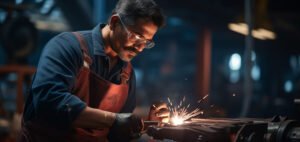In 2025, manufacturing sectors are experiencing a robust wave of transformation driven by Industrial Automation. While manufacturing sectors are vying to become efficient, cost-saving, and scalable to make, automation technologies take center stage in this revolution. From the assembly line to logistics, Industrial Automation is not science fiction—it’s reality today revolutionizing every aspect of industrial operation.
In the early decades of the 21st century, companies started incorporating machines and software in their operations. Today, Industrial Automation application has moved beyond the confines of mere robotic arms. Today, it encompasses intelligent manufacturing systems, predictive maintenance based on artificial intelligence, Internet of Things (IoT), and machine learning algorithms that allow industries to work smarter and not harder.
Demand for automation in industry is driven by a range of main drivers. First is precision. Human error, as natural as it may be, can prove costly at mass-production levels. Second, there is a global aspiration to be sustainable—automation systems are able to make the most of energy and reduce waste to the minimum. Third, faced with labour shortages and shifting skills needs, automation presents a solution that fills the gap between manpower availability and manufacturing needs.
The Birth of Intelligent Industrial Automation
Smart factories are the basis of automation today. Smart factories are those where physical manufacturing operations are connected to each other virtually in a way that real-time decision-making and improved responsiveness become possible. Such Industrial Automation depends on sensors, cloud computing, and analytics to anticipate issues, make manufacturing easier, and thereby improve competitiveness.
What is moving 2025 to a benchmark year in this process is the convergence of technologies. Artificial intelligence is no longer standalone—it’s now being merged with edge computing, robots, and even augmented reality to provide birth to fully aligned automation systems. These are not just systems that respond; these are systems that learn and mature. They detect anomalies, report performance feedback, and optimize operations automatically. It’s not only a revolution in manufacturing, but in cognition.
Industrial Automation for Small and Medium-Sized Businesses
While gigantic industries were the first to be the trendsetters, the Industrial Automation wave has finally reached the small and medium-sized businesses (SMEs). Cloud-based automation software has made entry costs plummet to enable even cash-strapped companies world-class manufacturing facility at reasonable prices. From automated packaging machines to CNC tools, SMEs are now achieving better quality and consistency of production without hiring additional personnel.
This democratization of automation is leveling the playing field. In 2025, SMEs don’t compete only on price—now they can compete on speed, precision, and reliability. Automation is helping get them lean, agile units that can spin on a dime to meet market need, especially in high-mix, low-volume production situations.
Skilling for the Age of Industrial Automation
By automating routine activities, the human labor force is moving towards that work requiring analytical capability, digital skill, and control system. In fact, one of the most important shifts in 2025 is that increasing up of automation literacy as technical education’s anchor competency.
Vocational training, apprenticeship, and academic-industry engagement are acquainting students and workers with automation architecture, industrial IoT, and programmable logic controllers (PLCs). Industrial Automation is transforming the way people collaborate and combining individuals and machines into one another’s requirements rather than replacing them.
Industrial Automation Challenges to Adoption
In spite of the huge benefits, the path to full automation is not without challenges. Legacy system integration with newer automation systems remains a challenge for most organizations. Furthermore, security becomes a concern in 2025. Factory digitalization exposes one to digital threats. Networked system security, data integrity, and regulatory compliance are some of the most important concerns in the automated industrial world of 2025.
The second is resistance that is cultural. Organizations used to doing things the old way are likely to be plagued by internal resistance to the implementation of Industrial Automation. Overcoming such barriers through managing change, training, and leadership alignment is needed for effective implementation.
The Economic Impact of Industrial Automation
At a macroeconomic level, the global Industrial Automation market will most likely surpass $350 billion by 2025. This is not just growth from manufacturing but also from oil and gas, pharma, food processing, and electronics segments. Automation is accelerating production, improving supply chain visibility, and reducing time-to-market in industries.
Other countries investing heavily in industrial technology also are making gains in GDP and export competitiveness. Governments and policy-makers also are offering incentives to embrace automation in the form of tax relief, research grants, and the creation of building infrastructure, further promoting the transition.
Sustainability and Green Manufacturing through Industrial Automation
Environmental consciousness is now a requirement; it’s not a matter of choice. Fortunately, Industrial Automation is leading the way towards the achievement of green manufacturing targets. Automated equipment is conceived with the thought of energy efficiency, material utilization, and waste reduction in mind. For industries like textile and automobile, automation has seen up to 30% reduction in water use, emissions, and non-recyclable wastage in just the past three years alone.
Monitoring and control in real time allow businesses to maximize functions beyond the limits of manual mechanisms. Whether for maintaining temperatures even to reduce loss of material or using AI for detecting leakages in fluidic systems, automation is reducing the green footprint of manufacturing operations.
The Future of Industrial Automation Beyond 2025
Looking forward to 2025 and beyond, the future of Industrial Automation is moving towards hyper-connectivity and autonomous decision-making. Quantum computing, 6G networks, and bio-integrated sensors can potentially revolutionize the way industries operate. Imagine self-sustaining supply chains or forecast algorithms that can re-schedule factories based on weather conditions or geopolitical developments.
Most importantly, automation is becoming smarter—it does not merely execute pre-programmed work, but learns from one round and improves upon the next. This makes it possible for flexible manufacturing when plants can switch between one line and another in a matter of hours, instead of weeks or days.
Conclusion: A Human-Centric View of Industrial Automation
Although it’s easy to create the story of machines and code, the real story of Industrial Automation is a human story. It’s a story of enabling workers to be productive contributors without being burdened by drudgery. It’s a story of enabling businesses of all shapes and sizes to build sustainably. And it’s a story of creating a future where technology enhances, not replaces, human potential.
Industrial Automation in 2025 is no longer an instrument—it’s a strategy. A growth and innovation and resilience strategy for a world that keeps changing and demands speed, sustainability, and smart thinking. As businesses renew and reinvent themselves, automation will remain the modest engine driving ahead.








